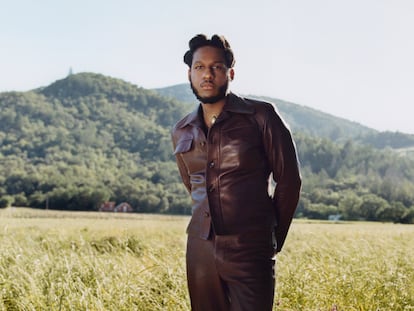From Juan Gabriel to Chico Buarque: Latin American music in 600 albums
Nineteen journalists from different countries in the region have compiled a long list that draws a sonic panorama of Latin America’s musical wealth

There have been many attempts to document the history and identity of Latin America through its music, whether from specific styles or visions. Worthy of mention are César Miguel Rondón’s The Book of Salsa (1980), or Raquel Z. Rivera’s Reggaeton (2009), although many others, working with limited resources, have tired themselves out.
A little over three years ago — knowing that making a long list is taking a risk as a curator — a group made up of 19 journalists from different parts of Latin America set themselves the titanic task of making a mile-long list of albums that could function as a sound panorama of the musical wealth of the entire region. Against all odds — and after a long journey of discussions, careful listening and revisions — the digital project of Los 600 de Latinoamérica was officially launched on July 16, after a preliminary release a few months earlier.
Desvelan la mastodóntica lista con los 600 mejores discos latinoamericanos de 1920 a 2022 https://t.co/orAJuLO6lm
— Rubén Blades (@rubenblades) July 20, 2024
A project by José Luis Mercado (Peru), Jorge Cárcamo (Chile), José Juan Zapata (Mexico), Felipe Figueroa (El Salvador) and Eduardo Rodríguez (Mexico) and 14 others reached the whopping number of 600 albums from different countries, eras and musical styles. Included in the list are collections from 1920 to 2022… 102 years in total.
Beyond being merely an orderly compendium of records, this review exposes outstanding aspects of the musical history of the region, its geopolitical context and evolution. Cárcamo explains the journalists’ thinking: “As we reviewed the different artists, we realized how genres influence each other between countries. For example, [look at] how cumbia arrived in northern Mexico. In one of Andrés Landero’s reviews, he also describes how [this folk music] appeared in Argentina in the 1980s and ended up influencing the accordion and the way we listen to cumbia today.”
“In the end,” the Chilean continues, “one realizes that Latin America has been well-connected since the 1930s and 1940s, since [Carlos] Gardel. For example, [Mexican singer] Jorge Negrete visited Chile in the 1940s, arrived at the central train station and was received as if he were Elvis Presley. One finds out about things like that by diving into all the genres.”
Shortly after its release on the internet, through its official website 600discoslatam.com, this independent publication has sparked joy, anger, and intense debate on social media, gaining the attention of the public in the region. Critics, journalists, and artists who are mentioned on the list have all weighed in. This includes Andrés Calamaro or Rubén Blades, who crowns the number one spot on the index with his 1978 album, Siembra, recorded alongside Willie Colón.
The Latin American 600 stands out for being a sort of celebratory window into the music of a region that, until recently, had been excluded from the discussion and mechanisms of cultural validation at a global level, especially considering the dominance of the English-language recording industry.
Laid out and digitally designed by José Juan Zapata, a Mexican journalist based in Argentina, the list can be approached by genre, country, numerical order, singer, or composer. It can also be consulted randomly, with the option of listening to the selection via digital platforms. This easy availability further facilitates a diverse, non-encyclopedic and flexible reading.
Cárcamo explains to EL PAÍS that, while the order isn’t chronological, the main purpose of telling the history of Latin American music is present in the list in different ways. This allows the index to address other types of historical records and attract a larger number of readers, compared to if a much more synthesized and conventional chronology had been drawn up instead.
“The criteria were always shaped little by little… but the main goal was to [include] albums that told part of the history of Latin American music and to try to leave out as little as possible, so that it wasn’t just about our discussions. Suddenly, we were choosing a lot of rock, or there were a lot of Argentine rock records, which we are all fans of, but they had to be left out in order to tell a wider variety of stories,” Cárcamo explains.

How does one rank an album by Los Prisioneros, Shakira, or Emmanuel above another by Charly García, Violeta Parra, or Caetano Veloso? Complexities, considerations and comparisons aside, the ranking of this list — a format that didn’t have the total consensus of those involved — is presented as a game that provokes and stimulates dialogue. This has clearly been fulfilled, revealing, in turn, the fractures within this collection.
“What has happened with the list is that a lot of people reacted both in favor of it and against it. Many were praising it, others were throwing a bit of hate… but within all that noise, there are people discovering music that catches their attention. All of this controversy allowed them to discover the music. It allowed me to remember things that I’d forgotten,” says Zapata, the Buenos Aires-based Mexican journalist.
“The rankings are easy to visualize,” he adds. “They help spread Latin American music, so that people can learn more, expand their musical options by countries, genres, or songs that they weren’t used to. It’s not about establishing a canon, but rather inviting people to play and to discuss, to also offer their own lists and choices.”
Through their X account, @600DiscosLATAM, those involved in the project republish and reshare all the opinions, threads and editorial pieces about the list that come their way, whether positive or not. There are often attacks on the presence of entirely digital productions, much more recent musical styles, such as trap, as well as records recorded in Indigenous languages, among others.
While people continue to learn about the 600 albums, discussing and listening to the songs, the compilers of the list don’t rule out a future in which it can be expanded. The list of songs could remain alive with further contributions from readers, or take the form of a reference book, transcending its digital and self-managed scope.
Sign up for our weekly newsletter to get more English-language news coverage from EL PAÍS USA Edition
Tu suscripción se está usando en otro dispositivo
¿Quieres añadir otro usuario a tu suscripción?
Si continúas leyendo en este dispositivo, no se podrá leer en el otro.
FlechaTu suscripción se está usando en otro dispositivo y solo puedes acceder a EL PAÍS desde un dispositivo a la vez.
Si quieres compartir tu cuenta, cambia tu suscripción a la modalidad Premium, así podrás añadir otro usuario. Cada uno accederá con su propia cuenta de email, lo que os permitirá personalizar vuestra experiencia en EL PAÍS.
¿Tienes una suscripción de empresa? Accede aquí para contratar más cuentas.
En el caso de no saber quién está usando tu cuenta, te recomendamos cambiar tu contraseña aquí.
Si decides continuar compartiendo tu cuenta, este mensaje se mostrará en tu dispositivo y en el de la otra persona que está usando tu cuenta de forma indefinida, afectando a tu experiencia de lectura. Puedes consultar aquí los términos y condiciones de la suscripción digital.
More information
Archived In
Últimas noticias
Most viewed
- Sinaloa Cartel war is taking its toll on Los Chapitos
- Oona Chaplin: ‘I told James Cameron that I was living in a treehouse and starting a permaculture project with a friend’
- Reinhard Genzel, Nobel laureate in physics: ‘One-minute videos will never give you the truth’
- Why the price of coffee has skyrocketed: from Brazilian plantations to specialty coffee houses
- Silver prices are going crazy: This is what’s fueling the rally











































